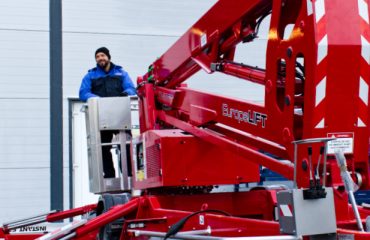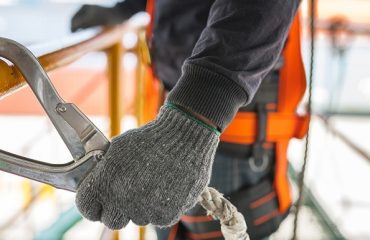Anyone who owns buildings built before 1985 should analyse whether the building contains asbestos. The same applies to builders who are planning work on buildings from the same period. A survey of asbestos can both reduce later costs and protect against exposure to hazardous asbestos dust.
Owners of buildings should have an overview of where there is and is not asbestos in the buildings. Such an overview will make it easier to prevent incidents involving exposure to asbestos-containing dust – both for their own employees and for other users of the building. Building owners should have an overview of asbestos materials even if there are no plans for work on the building. In addition to the increased risk and fear of serious health effects, interventions in asbestos-containing materials that are only discovered afterwards can have significant financial consequences. If renovation or remodelling of the buildings is initiated, the building owner will in most cases also take on the role of developer. The building owner will then have overall responsibility for planning with regard to safety, health and the working environment during the construction period.
Mapping and measures
Building owners should identify asbestos in buildings from before 1985. Building developers must map asbestos in such buildings before work is started on the buildings. A mapping of asbestos takes place in several phases, and is the same method for building owners and developers. It will usually be necessary to hire specialist expertise to identify possible asbestos in buildings and installations. This work is often carried out by environmental surveyors and the results of the survey are described in an environmental remediation report. Check that the environmental surveyors have the right expertise and experience in mapping asbestos. Not all environmental surveyors have specialised expertise in asbestos. When carrying out a survey, it is important to involve personnel who have knowledge of the building. Co-operation with caretakers and others who know the buildings well is a great advantage. However, if the survey reveals asbestos, decontamination is not always the best solution – see below. Decontamination involves a risk, because it always involves contamination with asbestos fibres in the air. Asbestos materials that are at rest and not damaged or weathered will not pose a risk.
Assess the risk of spreading asbestos fibres
If the building owner finds asbestos materials during a survey in a building where no building work is planned, the building owner must assess the risk of spreading asbestos fibres if the materials are left undisturbed. Asbestos-containing materials that are undamaged and at rest pose no risk. However, their condition may change over time, so the risk of asbestos fibre release may increase. There should therefore be a plan for regular risk assessment of the risk of spreading asbestos fibres. Dust with asbestos fibres is primarily formed when working with asbestos-containing material – for example, when drilling, drilling holes or cutting. Asbestos that is sprayed on surfaces adheres less well and can therefore more easily release dust during repairs and demolition. Normally, asbestos-containing panels do not pose a risk unless they are damaged, processed or subjected to stress. The risk is greater with semi-hard than with hard boards. A simple risk assessment can be to register the presence of asbestos in three categories:
- Risk class A – high risk of spreading asbestos fibres
- Risk class B – low risk of spreading asbestos fibres
- Risk class C – no risk of spreading asbestos fibres
| Room | Asbestos occurrence | Risk |
|---|---|---|
| Basement: Boiler room | Asbestos in boiler gaskets and some damage in pipe bends with asbestos insulation | A |
| 1st floor: Classrooms 101 and 102 | Asbestos in ceiling, overpainted perforated panels, no damage observed | C |
| 2nd floor: Corridor | Asbestos in wall panels, type asbestolux, approx. 200 m2. No visible damage, but risk of tears and release of asbestos fibres on contact with the panels (playing and pushing in the corridors) | B |
| Staircase | Vinyl tiles with detected asbestos in flooring and stair treads and repot. | C |
An example of how to carry out a survey project is well described in “Asbestos Handbook” by Evje, Mejdell, Johansen and Tesli.
Decontaminate or embed the asbestos?
If asbestos-containing material is found, both the building owner and the client must decide whether the asbestos should be decontaminated or encapsulated. As a general rule, materials containing asbestos should not be built in or encapsulated, as this will postpone the asbestos problem into the future. If there are specific plans for demolition or full remodelling or renovation of the building in the near future, encapsulation may be an acceptable temporary solution. In this context, it is important to emphasise that before demolition of a building, the building must first be decontaminated for asbestos. If asbestos-containing material is to be sealed, encapsulated or embedded, it is a prerequisite that a written risk assessment has been carried out. It is also a prerequisite that this is carried out in such a way that it effectively and safely prevents the spread of asbestos fibres. Embedding must be clearly labelled both on site and on all drawings of the building, so that unintentional processing is avoided and the asbestos is easy to identify in the future. Sealing, encapsulation and embedding that may involve a risk of asbestos fibre release must be carried out by a company licensed to work with asbestos.
Don’t build in a tiled roof
In practice, the Norwegian Labour Inspection Authority does not permit the installation of asbestos roofing due to the continued risk of spreading asbestos fibres. Such roof panels are always heavily weathered by wind and weather. The weathering of the panels will not stop even if the roof is built in. If the roof is built in, there will be no control over the spread of the asbestos fibres, which could also find their way into the building.
Mapping when working on buildings and installations
In demolition, renovation and maintenance work on buildings and installations constructed before 1985, the client must always take into account that there may be asbestos-containing materials in the building, both visible and hidden deposits. Asbestos surveys for major demolition and renovation projects should be carried out in three phases:
- Mapping when the building is in use.
- Mapping of hidden sources when the building is empty.
- Mapping at the start of the renovation process to uncover asbestos that may only become apparent during the actual demolition phase..
If a survey has only been carried out when the building is in use, this must be followed up with a new survey when the building is empty. It is only then that major interventions can be made to uncover any embedded asbestos-containing materials. A third survey should also be carried out at the start of the actual demolition phase. It is only then that more cases of hidden asbestos material may come to light. The environmental remediation report should include recommendations for such a third survey when necessary, and the client must ensure that it is carried out. The client can and should set requirements for the quality of an environmental decontamination report.
Obligations if asbestos is found during work on buildings and installations
If there are asbestos-containing materials in a building that is to be renovated or demolished, the client must ensure that the work to remove (or install) the asbestos is carried out by a company that has a licence from the Norwegian Labour Inspection Authority to carry out asbestos work. Information about asbestos must be included in tender documents and safety, health and working environment plans (SHA plans). The SHA plan must be based on risk assessments and be customised to the demolition, rehabilitation or maintenance work in question. Among other things, it must include a progress plan that describes when and how asbestos-containing materials are to be removed and handled. It must be taken into account that the decontamination of asbestos-containing materials must take place separately from other activities on the construction site. The SHA plans should describe that the decontamination company must notify the Labour Inspection Authority of the work in good time. When demolishing buildings or installations containing asbestos-containing materials, the asbestos should be removed before demolition. In most cases, this will be the safest way to carry out the work. In some special cases, the risk of removing the asbestos before the demolition work will be greater than if the asbestos is not removed. This may be the case, for example, if the asbestos-containing material is embedded in such a way that it is technically difficult to remove it. A specific assessment must be made of which working method poses the least risk to the workers.
Require post-control
It is very important that the client requires post-inspection of the asbestos work before other contractors are allowed access to the area. The inspection must ensure that all asbestos has been removed. In the case of internal remediation, the inspection should generally also include air samples.
Responsibility of owners of large buildings
Municipalities, county councils, health trusts, property companies and hotel chains, among others, own large building stock. For these organisations, it is therefore important to have good procedures in place when ordering assignments that may involve working with asbestos-containing materials in buildings. The procedures must ensure that the necessary surveys of possible asbestos materials are carried out before work is started. What asbestos is and where it can occur is often unknown to many craftsmen in the construction industry. Building owners must take responsibility for preventing situations where their own and other employees may be exposed to hazardous asbestos dust.




